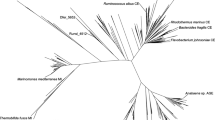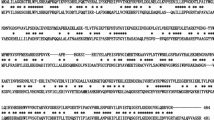Abstract
The gene encoding a putative mannose-6-phosphate isomerase (TnMPI) from Thermotoga neapolitana DSM4359 was cloned and expressed in Escherichia coli. TnMPI showed the highest isomerization activity between d-fructose and d-mannose at 75°oC in 50 mM Tris-HCl buffer (pH 7.5) containing 1 mM of Cu2+. TnMPI can be activated by some divalent metal ions, such as Cu2+, Mn2+, and Co2+. In the presence of 1 mM Cu2+, TnMPI activity on conversion from d-fructose to d-mannose was significantly enhanced up to 271% of that without Cu2+. In addition, its isomerization equilibrium between d-fructose and Dmannose was strongly affected by reaction temperature and pH. As reaction temperature decreased from 95 to 55°C, the equilibrium ratio of d-fructose to d-mannose was gradually shifted from 73:27 to 55:45. As reaction pH decreased from pH 8.5 to 5.5, the equilibrium ratio of Dfructose to d-mannose was shifted from 68:32 to 49:51.
Similar content being viewed by others
References
Granström TB, Takata G, Tokuda M, Izumori K. Izumoring: A novel and complete strategy for bioproduction of rare sugars. J. Biosci. Bioeng. 97: 89–94 (2004)
Kim BC, Lee YH, Lee HS, Lee DW, Choe EA, Pyun YR. Cloning, expression, and characterization of l-arabinose isomerase from Thermotoga neapolitana: Bioconversion of d-galactose to Dtagatose using the enzyme. FEMS Microbiol. Lett. 212: 121–126 (2002)
Yeom SJ, Kim NH, Park CS, Oh DK. l-Ribose production from Larabinose by using purified l-arabinose isomerase and mannose-6-phosphate isomerase form Geobacillus thermodenitrificans. Appl. Environ. Microb. 75: 6941–4943 (2009)
Proudfoot AEI, Goffin L, Payton MA, Wells TNC, Bernard AR. In vivo and in vitro folding of a recombinant metalloenzyme, phosphomannose isomerase. Biochem. J. 318: 437–442 (1996)
Proudfoot AEI, Payton MA, Wells TNC. Purification and characterization of fungal and mammalian phosphomannose isomerases. J. Protein Chem. 13: 619–627 (1994)
Yeom SJ, Ji JH, Kim NH, Park CS, Oh DK. Substrate specificity of a mannose-6-phosphate isomerase from Bacillus subtilis and its application in the production of l-ribose. Appl. Environ. Microb. 75: 4705–4710 (2009)
Yeom SJ, Kim NH, Yoon RY, Kwon HJ, Park CS, Oh DK. Characterization of a mannose-6-phosphate isomerase from Geobacillus thermodenitrificans that converts monosaccharides. Biotechnol. Lett. 31: 1273–1278 (2009)
Yeom SJ, Kim YS, Lim YR, Jeong KW, Lee JY, Kim Y, Oh DK. Molecular characterization of a novel thermostable mannose-6-phosphate isomerase from Thermus thermophilus. Biochimie 93: 1659–1667 (2011)
Davis JA, Freeze HH. Studies of mannose metabolism and effects of long-term mannose ingestion in the mouse. Biochim. Biophys. Acta 1528: 116–126 (2001)
de Koning TJ, Dorland L, van Diggelen OP, Boonman AMC, de Jong GJ, van Noort WL, De Schryver J, Duran M, van den Berg IE, Gerwig GJ, Berger R, PolL-The BT. A novel disorder of Nglycosylation due to phosphomannose isomerase deficiency. Biochem. Bioph. Res. Co. 245: 38–42 (1998)
DeRossi C, Bode L, Eklund EA, Zhang F, Davis JA, Westphal V, Wang L, Borowsky AD, Freeze HH. Ablation of mouse phosphomannose isomerase (Mpi) causes mannose 6-phosphate accumulation, toxicity, and embryonic lethality. J. Biol. Chem. 281: 5916–5927 (2006)
Ishrud O, Zahid M, Ahmad VU, Pan Y. Isolation and structure analysis of a glucomannan from the seeds of Libyan dates. J. Agr. Food Chem. 49: 3772–3774 (2001)
Yeom SJ, Seo ES, Kim BN, Kim YS, Oh DK. Characterization of a mannose-6-phosphate isomerase from Thermus thermophilus and increased l-ribose production by its R142N mutant. Appl. Environ. Microb. 77: 762–767 (2011)
Hansen T, Urbanke C, Schönheit P. Bifunctional phosphoglucose/phosphomannose isomerase from the hyperthermophilic archaeon Pyrobaculum aerophilum. Extremophiles 8: 507–512 (2004)
Hansen T, Wendorff D, Schonheit P. Bifunctional phosphoglucose/phosphomannose isomerase from the archaea Aeropyrum pernix and Thermoplasma acidophilum constitute a novel enzyme family within the phosphoglucose isomerase superfamily. J. Biol. Chem. 279: 2262–2272 (2004)
Mizanur RM, Pohl NLB. Phosphomannose isomerase/GDPmannose pyrophosphorylase from pyrococcus furiosus: A thermostable biocatalyst for the synthesis of guanidine diphosphateactivated and mannose-containing sugar nucleotides. Org. Biomol. Chem. 7: 2135–2139 (2009)
Roux C, Lee JH, Jeffery CJ, Salmon L. Inhibition of type I and type II phosphomannose isomerases by the reaction intermediate analogue 5-phospho-d-arabinonohydroxamic acid supports a catalytic role for the metal cofactor. Biochemistry 43: 2926–2934 (2004)
Park JM, Han NS, Kim TJ. Rapid detection and isolation of known and putative α-l-arabinofuranosidase genes using degenerate PCR primers. J. Microbiol. Biotechn. 17: 481–489 (2007)
Groussac E, Ortiz M, François J. Improved protocols for quantitative determination of metabolites from biological samples using high performance ionic-exchange chromatography with conductimetric and pulsed amperometric detection. Enzyme Microb. Tech. 26: 715–723 (2000)
Roux C, Bhatt F, Foret J, de Courcy B, Gresh N, Piquemal JP, Jeffery CJ, Salmon L. The reaction mechanism of type I phosphomannose isomerases: New information from inhibition and polarizable molecular mechanics studies. Proteins 79: 203–220 (2011)
Author information
Authors and Affiliations
Corresponding author
Rights and permissions
About this article
Cite this article
Shin, HC., Jang, MU., Lee, HG. et al. Effect of temperature and ph on interconversion between fructose and mannose catalyzed by Thermotoga neapolitana mannose-6-phosphate isomerase. Food Sci Biotechnol 22 (Suppl 1), 39–44 (2013). https://doi.org/10.1007/s10068-013-0046-4
Received:
Revised:
Accepted:
Published:
Issue Date:
DOI: https://doi.org/10.1007/s10068-013-0046-4




